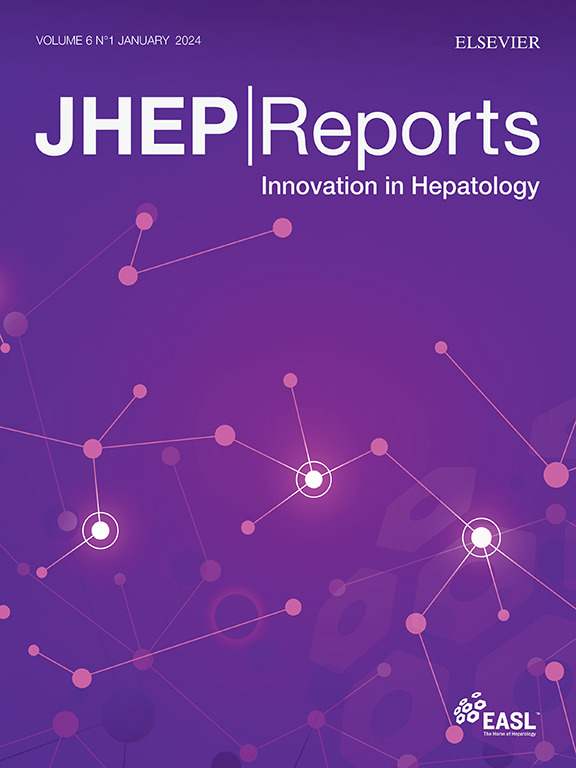Prediction of long-term HBsAg seroclearance in patients with HBeAg-negative chronic hepatitis B
IF 9.5
1区 医学
Q1 GASTROENTEROLOGY & HEPATOLOGY
引用次数: 0
Abstract
Background & Aims
Predicting the long-term HBsAg seroclearance, an ideal endpoint, is relevant for decision-making regarding antiviral therapy for patients with chronic hepatitis B (CHB). This study aimed to identify predictors and develop a prediction model for HBsAg seroclearance in patients with HBeAg-negative CHB.
Methods
A total of 2,032 untreated HBeAg-negative patients who underwent a 2-year baseline observation period were enrolled. Prediction models were developed using independent predictors of seroclearance, and their performance was evaluated through internal and external validation using an independent cohort of 753 patients, along with sensitivity analyses.
Results
The estimated annual incidence of HBsAg seroclearance was 2.22% (15,508 person-years). Hepatitis B virus DNA Level (Low-to-intermittently high-level viremia), Old age, male Sex, and hepatitis B Surface antigen level <250 IU/ml independently predicted seroclearance. Subsequently, two prediction models were developed: HepBLOSS-1 and a simplified version, HepBLOSS-2. These models demonstrated excellent performance in predicting seroclearance at 5, 10, and 15 years, with C-indices and time-dependent area under the receiver operating characteristics curve (AUROC) values of 0.81–0.89. The 10-year cumulative incidence rate in patients with scores of ≥13 in HepBLOSS-1 and those with scores of 8 in HepBLOSS-2 was over 50%. Both models underwent rigorous internal and external validation, demonstrating good predictability with time-dependent AUROCs exceeding 0.80. The predicted seroclearance rate closely aligned with the observed rate in both models.
Conclusions
The HepBLOSS models for HBsAg seroclearance exhibited an outstanding ability to stratify the probability of seroclearance over a 15-year period. These models hold promising potential to guide treatment decisions, aiming to achieve a functional cure in patients with CHB.
Impact and implications
Achieving a functional cure for chronic hepatitis B, defined as HBsAg seroclearance, is a realistic treatment endpoint, especially given the virus’s lifelong persistence in hepatocytes and its significant association with improved prognosis. This study identified independent predictors of seroclearance, including HBV DNA levels, age, sex, and HBsAg levels, and developed a robust prediction model based on these factors. The models demonstrated strong predictive accuracy over a 15-year period, offering valuable guidance for clinicians in establishing treatment strategies and predicting patient prognosis.
hbeag阴性慢性乙型肝炎患者长期HBsAg血清清除率的预测
背景,目的预测慢性乙型肝炎(CHB)患者的长期HBsAg血清清除率是一个理想的终点,它与慢性乙型肝炎(CHB)患者抗病毒治疗的决策有关。本研究旨在确定hbeag阴性CHB患者HBsAg血清清除率的预测因子并建立预测模型。方法共纳入2032例未经治疗的hbeag阴性患者,接受2年基线观察期。使用血清清除率的独立预测因子建立预测模型,并通过使用753例患者的独立队列进行内部和外部验证以及敏感性分析来评估其性能。结果估计年HBsAg清除率为2.22%(15508人年)。乙型肝炎病毒DNA水平(低至间歇性高水平病毒血症)、年龄、男性和乙型肝炎表面抗原水平(250 IU/ml)独立预测血清清除率。随后,开发了两种预测模型:hepblossoms -1和简化版hepblossoms -2。这些模型在预测5年、10年和15年的血清清除率方面表现出色,c指数和受试者工作特征曲线下的时间依赖面积(AUROC)值为0.81-0.89。hepblossoms -1评分≥13分和hepblossoms -2评分为8分的患者10年累积发病率均超过50%。两个模型都经过严格的内部和外部验证,显示出良好的可预测性,与时间相关的auroc超过0.80。在两种模型中,预测的血清清除率与观察到的清除率密切一致。结论:hepblos模型对15年期间的HBsAg血清清除率进行分层,显示出出色的能力。这些模型具有指导治疗决策的潜力,旨在实现慢性乙型肝炎患者的功能性治愈。影响和意义实现慢性乙型肝炎的功能性治愈,定义为HBsAg血清清除,是一个现实的治疗终点,特别是考虑到病毒在肝细胞中的终身存在及其与预后改善的显着相关性。本研究确定了血清清除率的独立预测因素,包括HBV DNA水平、年龄、性别和HBsAg水平,并基于这些因素建立了一个强大的预测模型。这些模型在15年的时间里显示出很强的预测准确性,为临床医生制定治疗策略和预测患者预后提供了有价值的指导。
本文章由计算机程序翻译,如有差异,请以英文原文为准。
求助全文
约1分钟内获得全文
求助全文
来源期刊

JHEP Reports
GASTROENTEROLOGY & HEPATOLOGY-
CiteScore
12.40
自引率
2.40%
发文量
161
审稿时长
36 days
期刊介绍:
JHEP Reports is an open access journal that is affiliated with the European Association for the Study of the Liver (EASL). It serves as a companion journal to the highly respected Journal of Hepatology.
The primary objective of JHEP Reports is to publish original papers and reviews that contribute to the advancement of knowledge in the field of liver diseases. The journal covers a wide range of topics, including basic, translational, and clinical research. It also focuses on global issues in hepatology, with particular emphasis on areas such as clinical trials, novel diagnostics, precision medicine and therapeutics, cancer research, cellular and molecular studies, artificial intelligence, microbiome research, epidemiology, and cutting-edge technologies.
In summary, JHEP Reports is dedicated to promoting scientific discoveries and innovations in liver diseases through the publication of high-quality research papers and reviews covering various aspects of hepatology.
 求助内容:
求助内容: 应助结果提醒方式:
应助结果提醒方式:


